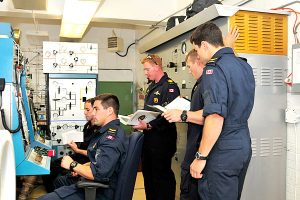Under Pressure
By Lookout on Sep 29, 2014 with Comments 0
At first glance the Hyperbaric Chamber at Fleet Diving Unit (Pacific) (FDU(P)) looks like a time machine or even a futuristic prison cell; but the students of the Clearance Diver Course quickly learned it’s the best way to save a diver’s life.
Gathered around the many knobs, buttons, and valves rising from the consoles, they were instructed on the procedures for treating divers whose bodies have become acclimatized to various depths and pressures.
The normal atmospheric condition experienced on dry land is called normobaric pressure. When divers go under the surface, the pressure of the water and air above them increases with depth. This additional pressure causes several changes in the way a human body processes blood gases such as oxygen and nitrogen. If a diver surfaces too quickly, the gases in the blood can convert to bubbles and cause a very dangerous situation called the bends, or decompression sickness. A hyperbaric chamber can return a diver to the same depth and pressure experienced during the actual dive. This procedure in the hyperbaric chamber allows the nitrogen in the bubbles to escape naturally, leaving only absorbable oxygen.
“It can be a fairly complicated process, but it’s absolutely vital to get it right,” says LS Mathew Kyte, one of the instructors at FDU (P). “This is just one piece of the Clearance Diver Course, but it is a very important one, and we want to make sure everyone is prepared for anything.”
When a diver surfaces and is considered to be at a risk of decompression related injuries, they’re moved to the hyperbaric chamber, which works by pumping pressurized air into the metal container. The diver remains in the chamber anywhere from four to eight hours, sometimes more, until the pressure inside can be slowly lessened to normal.
“Not taking proper precautions when coming to the surface can cause all sorts of problems. Decompression sickness and gas embolisms are things we use the hyperbaric chamber to treat,” says LS Kyte. “This is a vital tool in emergency situations, and a very important part of Clearance Diver training.”
With the students gathered around the chamber, LS Kyte explained the sensation divers feel on dry land in the chamber.
“Actually feeling that pressure on dry land can feel sort of strange,” LS Kyte explained to the gathered students. “The air becomes very thick because of all the air molecules being crammed in there. That causes a tonne of strange things to happen.”
Those things can include voices sounding higher, like breathing helium in, due to vocals chord reacting to the density of the air, heat from molecule friction, and even the slowing of dropped objects due to heavy air resistance.
“It’s like sitting in soup,” says LS Kyte. “Everyone is sitting in this hot, humid room, voices getting high, and the higher levels of nitrogen in the blood make everyone feel a little drunk. It can be a very strange few hours.”
The Chamber itself it about the size of a minivan, but its different components are spread across several buildings at the FDU (P) facilities, each piece of which the students are carefully drilled on.
Air is brought in through intakes, pressurized, and pumped into the hyperbaric chamber building, where its flow is then controlled. Depending on the pressure the diver’s body is acclimatized to, the controls can be used to recreate the relative pressure inside the chamber.
The Recompression and Hyperbaric Medicine training is just a small part of the overall Clearance Diver Course, which will see participants put through a year’s worth of intensive physical, mental, and operations training.
At the end, those who make it through will be fully qualified Clearance Divers, tasked with disarming and dismantling explosive ordnance both above and below water.
“It’s a tough course to get through. You have to be at the top of your game,” says LS Kyte. “I think we’ve got some great guys this year, though. I think I’ll be seeing a lot of them in a year’s time.”
Shawn O’Hara, Staff Writer
Filed Under: Top Stories
About the Author:






